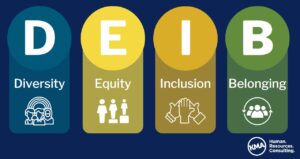By the Pros at the HR Support Center
Though we’re all different, we can all thrive in the same workplace.
 That’s the motivating belief behind efforts to increase diversity, equity, inclusion, and belonging (DEIB). When done well, these efforts redesign the workplace from an environment that holds certain people back to one that empowers everyone to succeed. Together, they create an environment where people know it’s safe for them to show up as themselves—where they’re welcomed, wanted, rewarded, and celebrated.
That’s the motivating belief behind efforts to increase diversity, equity, inclusion, and belonging (DEIB). When done well, these efforts redesign the workplace from an environment that holds certain people back to one that empowers everyone to succeed. Together, they create an environment where people know it’s safe for them to show up as themselves—where they’re welcomed, wanted, rewarded, and celebrated.
Unsurprisingly, the majority of employees want to work for an employer who values these principles. In general, people want to belong; they don’t want to feel isolated and alone, be treated unfairly, or find themselves excluded. Also of no surprise: DEIB efforts have been shown to drive business performance and innovation, balanced organizational management, improved decision making, and increased competitive advantage.
While the terms diversity, equity, inclusion, and belonging are similar, each word has a specific meaning and importance in the workplace. Let’s go over each one.
Diversity
Diversity is the measure of representation in a place—particularly the representation of groups that have historically faced discrimination in the workplace. For example, a leadership team that includes women, transgender, Black, and disabled employees would be more diverse than a leadership team comprised mostly of able-bodied white cisgender men. While the latter is much more common, diversity efforts are meant to change that.
Increasing diversity can be a challenge. For one, basing hiring decisions on membership in underrepresented groups generally runs afoul of antidiscrimination laws. For another, the degree to which an employer can significantly increase diversity may depend greatly on the overall diversity of their applicant pool. A tech company able to hire remote employees nationally or internationally will likely have a more diverse workforce than a restaurant in a small town with a homogenous population, regardless of the effort put in to increasing diversity.
A diverse team signals to job applicants, employees, and customers that your organization exists for them. Measuring and monitoring diversity is important because decreased diversity may indicate that your organization is not as welcoming as you want or need it to be. For example, if an organization committed to diversity noticed a trend of people of color quitting at a higher rate than white employees, it would investigate to make sure no harassment, intimidation, or bias is occurring and put a stop to it if it is.
Equity
As organizations become more diverse, their focus may shift to addressing issues with equity such as inequitable access to training, promotions, or other opportunities. Equity means giving each employee what they need to be successful. It’s more than providing all employees with access to the same resources and opportunities. Equity acknowledges that people have different needs, pressures, obstacles, and pathways to success. The accommodation that enables one person to do their job well may not be helpful for another. The practice that seems to work well for most people may be a hindrance to a few. Equity aims to correct these imbalances.
Inclusion
Inclusion is the work done to make everyone feel like a valued member of the team—appreciated and supported. Inclusion ensures that everyone feels safe being themselves, empowered to do their best, and rewarded fairly for their efforts.
Leaders at inclusive workplaces will often invest in employee resource groups (ERGs), encourage employee participation, set aside time for sharing and celebrations, listen to what these groups have to say about DEIB challenges in the organization, and make changes when helpful. A sign that an organization has an inclusive culture is that it regularly makes decisions based on feedback and input from employees.
Inclusive managers actively support and advocate for their people. As Minda Harts, CEO of The Memo LLC, notes, Black women generally receive far less professional investment from managers than their white counterparts. That’s true of other groups as well—employees with disabilities, for example. When people don’t feel appreciated, valued, and supported, they tend to leave, and that in turn can make organizations less equitable and diverse—not to mention that turnover can be very costly.
Belonging
Belonging is the outcome of the work organizations put into diversity, equity, and inclusion. Belonging is the connection employees feel to their organization because of that work. It’s what motivates them to invest in their organization’s success and the success of their coworkers.
Employees who know they belong feel like they have a place, that they are wanted, that the community wouldn’t be the same without them. They’re more inclined to stay and work for positive change, as opposed to quitting, hoping for a more supportive environment.
